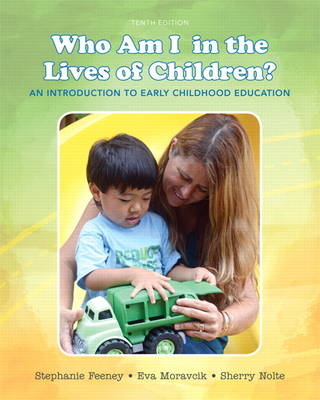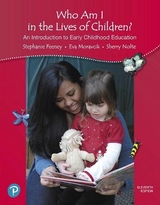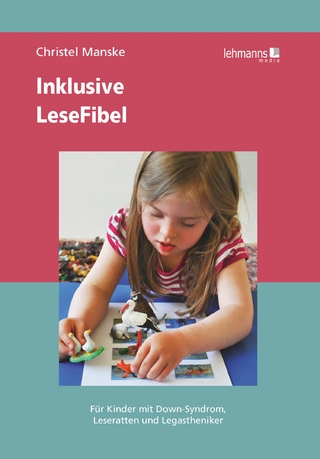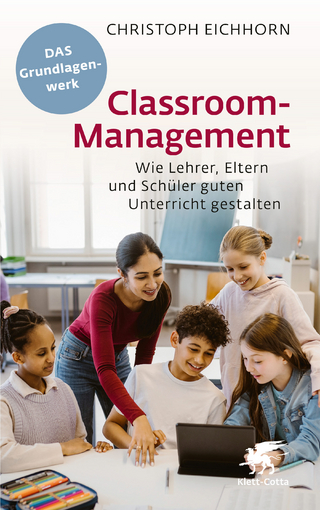
Who Am I in the Lives of Children? An Introduction to Early Childhood Education
Pearson (Verlag)
978-0-13-376418-5 (ISBN)
- Titel erscheint in neuer Auflage
- Artikel merken
A warm and comprehensive child-centered approach to early childhood education
Who Am I in the Lives of Children? An Introduction to Early Childhood Education presents a constructivist approach to early childhood education (birth to grade 3) and care programs that is dedicated to the development of the whole child—physical, social, emotional, and intellectual. With its practical orientation; personal voice; appealing photographs, videos, authentic children’s classroom work; and engaging stories, it allows readers to visualize effective classroom practices. Aspiring educators are encouraged to learn about each child’s strengths, interests, and challenges. This understanding, coupled with contemporary, research-based information, inspires readers to support each child’s growth and learning in ways that are in harmony with who they are, rather than according to a predetermined plan. The Enhanced Pearson eText features embedded video and assessments.
Improve mastery and retention with the Enhanced Pearson eText*
The Enhanced Pearson eText provides a rich, interactive learning environment designed to improve student mastery of content. The Enhanced Pearson eText is:
Engaging. The new interactive, multimedia learning features were developed by the authors and other subject-matter experts to deepen and enrich the learning experience.
Convenient. Enjoy instant online access from your computer or download the Pearson eText App to read on or offline on your iPad® and Android® tablet.*
Affordable. The Enhanced Pearson eText may be purchased stand-alone or with a loose-leaf version of the text for 40-65% less than a print bound book.
*The Enhanced eText features are only available in the Pearson eText format. They are not available in third-party eTexts or downloads.
*The Pearson eText App is available on Google Play and in the App Store. It requires Android OS 3.1-4, a 7” or 10” tablet, or iPad iOS 5.0 or later.
Stephanie Feeney Ph.D. is Professor Emerita of Education at the University of Hawaii at Manoa and Adjunct Professor in the Graduate School of Education at Portland State University. Her publications include Who Am I in the Lives of Children? (10 editions), Continuing Issues in Early Childhood Education (3rd edition), Professionalism in Early Childhood Education: Doing Our Best for Young Children, the NAEYC Code of Ethical Conduct, two books about professional ethics in early childhood education published by NAEYC, a curriculum for young children, numerous chapters and articles, and four books about Hawaii for young children. She has served on the Governing Boards of the National Association for the Education of Young Children (NAEYC) and the National Association for Early Childhood Teacher Educators (NAECTE), and on committees relating to school readiness, early learning standards, advocacy and other aspects of early childhood policy. She has lectured and taught throughout the United States and in China, Japan, Hong Kong, Singapore, Australia, New Zealand and Canada. Eva Moravcik is Professor of Early Childhood Education at Honolulu Community College where she teaches early childhood classes for adults and oversees the Leeward Community College Children’s Center. She has been a preschool, afterschool and kindergarten teacher, center director, education coordinator, consultant, and CDA trainer. Her publications include Meaningful Curriculum for Young Children (Pearson), Who Am I in the Lives of Children? (9 editions), Teaching the NAEYC Code of Ethical Conduct published by NAEYC, Discovering Me and My World a curriculum for young children, and articles on early childhood education. She has served on the Governing Boards of the State and Oahu Chapters of the Hawaii Association for the Education of Young Children (HAEYC) and The National Associate Degree Early Childhood Teacher Educators Association (ACCESS), the editorial board of NAEYC, as well as on the boards of other early childhood related organizations in Hawaii. Her daily work with children, family, staff, and college students at Leeward Community College Children’s Center provides her with grounding in the reality of life in a program for young children. Sherry Nolte recently retired as Professor of Early Childhood Education at Honolulu Community College where she specialized in teaching classes for infant and toddler teachers as well as classes in child development, child guidance and preschool curriculum. She has been a preschool teacher, a toddler teacher, a program director, and a staff trainer. She currently works as a consultant to early childhood programs in Hawaii and as a trainer and curriculum developer. She also teaches college classes at Honolulu Community College as an Adjunct Professor. She is a co-author of Who Am I in the Lives of Children? and Meaningful Curriculum for Young Children. She has served on the governing board of the Hawaii Association for the Education of Young children as well as on boards of several other early childhood organizations in Hawaii.
Brief Table of Contents
Chapter 1 The Teacher
Chapter 2 The Field of Early Childhood Education
Chapter 3 History of Early Childhood Education
Chapter 4 Child Development
Chapter 5 Observing and Assessing Young Children
Chapter 6 Relationships and Guidance
Chapter 7 Health, Safety, and Well-Being
Chapter 8 The Learning Environment
Chapter 9 Understanding and Supporting Play
Chapter 10 The Curriculum
Chapter 11 Curriculum Planning
Chapter 12 Including All Children
Chapter 13 Partner-ships with Families
Chapter 14 Becoming an Early Childhood Professional
Detailed Table of Contents
Chapter 1 The Teacher
The Work of the Early Childhood Education
The Tasks
Working with Families
Working as Part of a Team
The Teacher as a Person
Qualities of a Good Teacher of Young Children
Personal Attributes
Personal Values and Morality
Attitudes Toward Diversity
The Impact of Life Experiences
The Teacher as a Professional
Specialized Knowledge and Skills
Professional Commitment and Behavior
Legal Responsibilities
Professional Values and Ethics
Careers in Early Childhood: Finding Your Path
Roles
Educational Requirements
Stages of Professional Development
Final Thoughts
Chapter 2 The Field of Early Childhood Education
Types of Programs for Young Children
Children Served
Purpose
Facilities
Sponsorship and Funding
Programs for Children from Birth to Age 5
Child Care
Programs Whose Primary Purpose is Education
Early Childhood Family Education
State-Funded Public Prekindergarten Programs
Programs for Children from 5 to 8 Years
Kindergarten Through Grade 3 Programs: Primary Grades
Charter Schools
Home Schools
Programs for Children from Birth to Age Eight Who Have Disabilities
Early Intervention
Preschool Programs for Children with Disabilities
Public School Programs for 5- to 8-Year-Olds with Disabilities
Program Accountability
Program Regulation
Educational Standards
Early Learning Standards
Common Core Standards
School Readiness
Final Thoughts
Chapter 3 History of Early Childhood Education
The Origins of Early Childhood Education
Ancient Greece and Rome (400 B.C.- A.D. 200)
The Middle Ages (500-1450)
The Renaissance and The Reformation (1300-1600)
The Age of Enlightenment (1700s)
The Industrial Revolution (1800s)
Educational Movements That Shaped the Field of Early Childhood Education
Froebel and The Kindergarten
Margaret and Rachel McMillan and the Nursery School
John Dewey and Progressive Education
Contemporary Examples
Three European Approaches
The Montessori Method
Waldorf Education
The Reggio Amelia Approach
Common Elements of the Three Approaches
Child Care in the United States
The Origins of Child Care in the United States
Child Care in Times of National Emergency
Child Care after World War II
The Evolution of Early Childhood Education and Care
Final Thoughts
Chapter 4 Child Development
Why Study Child Development?
Principles of Child Development
The Child Develops as a Whole
Development Follows Predictable Patterns
Rates of Development Vary
Development is Influenced by Maturation and Experience
Development Proceeds from Top Down and from Center Outward
Culture Affects Development
Applying Principles to Practice
Heredity and Environment
The Biological Basis of Development
The Impact of Environment
Theories of Development
Arnold Gesell and Maturational Theory
Jean Piaget and Constructivist Theory
Laurence Kohlberg and Moral Development Theory
Lev Vygotsky and Sociocultural Theory
Urie Bronfenbrenner and Ecological Theory
Erik Erikson and Psychosocial Theory
B. F. Skinner and Behaviorist Theory
Howard Gardner and Multiple Intelligences Theory
Abraham Maslow and Self-Actualization Theory
Development of the Whole Child
Domains of Development
Periods of Development
Understanding Infants’ Development
Understanding Toddlers’ Development
Understanding Preschoolers’/Kindergartners’ Development
Understanding Young School-Age Children’s Development
Final Thoughts
Chapter 5 Observing and Assessing Young Children
The Purpose of Assessment
Authentic Assessment
Learning to Observe
Beyond Observation: Other Authentic Assessment Methods
Portfolios
Sharing Authentic Assessment
Standardized Assessment
Kinds of Standardized Assessment Instruments
Concerns with Standardized Testing
Final Thoughts
Chapter 6 Relationships and Guidance
The Foundations of Child Guidance
Relationships
Understanding and Honoring Differences
Knowledge of Development
Goals for Guidance
Long-Term Goals
Short-Term Goals
Communication: A Powerful Guidance Tool
Respectful and Authentic Speech
Listening
Responding
Guiding Groups
Use Authority
Create Guidelines for Behavior
Anticipate Problems
Orchestrate Transitions
Manage Large Group Times
Classroom Climate
Create a Supportive Environment
Encourage Friendships
Model and Teach Respect and Fairness
Teach Children to Deal with Conflict
Managing Inappropriate Behaviors
Reframing Misbehavior as “Mistaken Behavior”
Strategies for Dealing with Mistaken Behavior
Bullying
Challenging Behaviors
Final Thoughts
Chapter 7 Health, Safety, and Well-Being
Why Study Safety, Health, and Well-Being?
Safe Places for Children
What Is Safe?
Developmental Differences and Safety
Safe Outdoor Environments
Vehicle and Trip Safety
Safe Indoor Environments
Practices That Promote Safety
Helping Children Learn to Be Safe
Protecting Children from Abuse and Neglect
Healthy Places for Young Children
Understand How Illness Spreads
Follow Healthy Routines
Work with a Health Care Professional
Know About Conditions That Affect Health
Help Children Learn to be Healthy
Promote Physical Activity and Movement
Encourage Healthy Food Choices
Make Health a Part of the Curriculum
Use Personal Care Routines as Teaching Opportunities
Well-Being
The Importance of Touch
Good Transitions Support Well-Being
Supporting Children During Times of Crisis
Final Thoughts
Chapter 8 The Learning Environment
The Indoor Learning Environment
Space
Equipment and Materials
Making the Indoor Environment Work
The Outdoor Learning Environment
Outdoor Activity Zones
An Outdoor Playscape for Infants and Toddlers
Using the Outdoor Environment
Different Children – Different Places
Infant–Toddler Environments: A Place Like Home
Preschool and Kindergarten Classrooms: A Child’s Place
Primary Classrooms: A Place Called School
Including Children with Disabilities
Time
The Daily Schedule
Final Thoughts
Chapter 9 Understanding and Supporting Play
Understanding Play
Characteristics of Play
Kinds of Play
Why Children Play
Theories of Play
Stages of Play
The Role of Play in Development
The Role of Play in Physical Development
The Role of Play in Emotional Development
The Role of Play in Social Development
The Role of Play in Cognitive Development
The Role of Play in Integrating Development
The Special Role of Outdoor Play
Explaining Play
Facilitating Play
Supportive Attitudes
Supportive Roles
Issues in Play
Diversity and Play
Gender-Stereotyped Play
Violent Dramatic Play
Rough-and-Tumble Play
Exclusion—You Can’t Say You Can’t Play
Shrinking Opportunities for Play
Final Thoughts
Chapter 10 The Curriculum
What is Curriculum?
Where Does Curriculum Come From?
How Young Children Learn
Curriculum in Early Childhood Education
How Early Childhood Teachers Teach
The Physical Development Curriculum
Gross Motor Curriculum
Fine Motor Curriculum
Sensory Development Curriculum
The Communication Curriculum
Language Curriculum
Literacy Curriculum
Literature Curriculum
The Creative-Arts Curriculum
Visual Art Curriculum
Music Curriculum
Creative Movement Curriculum
Aesthetics Curriculum
The Inquiry Curriculum
Math Curriculum
Science Curriculum
Social Studies Curriculum
Final Thoughts
Chapter 11 Curriculum Planning
Why Teachers Plan
What Influences Planning
What You Teach
How Curriculum Is Organized
What Goes in a Plan
Basing Plans on What You Observe
Teaching Methods or Strategies
Writing Plans
Activity or Lesson Plans
Weekly Plans
Planning an Integrated Study
Final Thoughts
Chapter 12 Including All Children
Dual Language Learners
Working with Dual Language Learners in ECE Programs
Children with Disabilities
Terminology
Laws Governing Services to Children with Disabilities
Programs for Children from Birth Through Age 2
Programs for Children 3 to 5 Years of Age
Programs for Children 5 to 8 Years of Age
Identification of Disabilities
Inclusion
Characteristics of Young Children with Disabilities
Children with other Special Needs
Children with Special Gifts and Talents
Children Who Have Been Abused or Neglected
Children with Acute or Chronic Health Conditions
Working with Families of Children with Disabilities
Final Thoughts
Chapter 13 Partner-ships with Families
Understanding Families/Understanding Yourself
Responsibilities of Today’s Families
Diverse Families
Family Systems Theory
Understanding Yourself
Building Relationships with Families
Establishing Relationships with Families
Strong Beginnings
Home Visits
Communicating
Confidentiality
Engaging Families in Your Program
Classroom Involvement
Program Involvement
Family Education
Supporting Families
Helping in Times of Stress
Preventing and Reporting Child Abuse and Neglect
Supporting Families of Children with Disabilities
Final Thoughts
Chapter 14 Becoming an Early Childhood Professional
Part I: Current Realities in Early Childhood Education
A Changing Society
Continuing Issues
Developments in Early Childhood Policy
Part II: Becoming a Professional
Knowledge and Skill
Professional Behavior
Personal Characteristics
Choose Your Path
Take Care of Yourself
| Erscheint lt. Verlag | 13.1.2015 |
|---|---|
| Sprache | englisch |
| Maße | 200 x 250 mm |
| Gewicht | 1041 g |
| Themenwelt | Sozialwissenschaften ► Pädagogik ► Schulpädagogik / Grundschule |
| Sozialwissenschaften ► Pädagogik ► Vorschulpädagogik | |
| ISBN-10 | 0-13-376418-4 / 0133764184 |
| ISBN-13 | 978-0-13-376418-5 / 9780133764185 |
| Zustand | Neuware |
| Haben Sie eine Frage zum Produkt? |
aus dem Bereich



